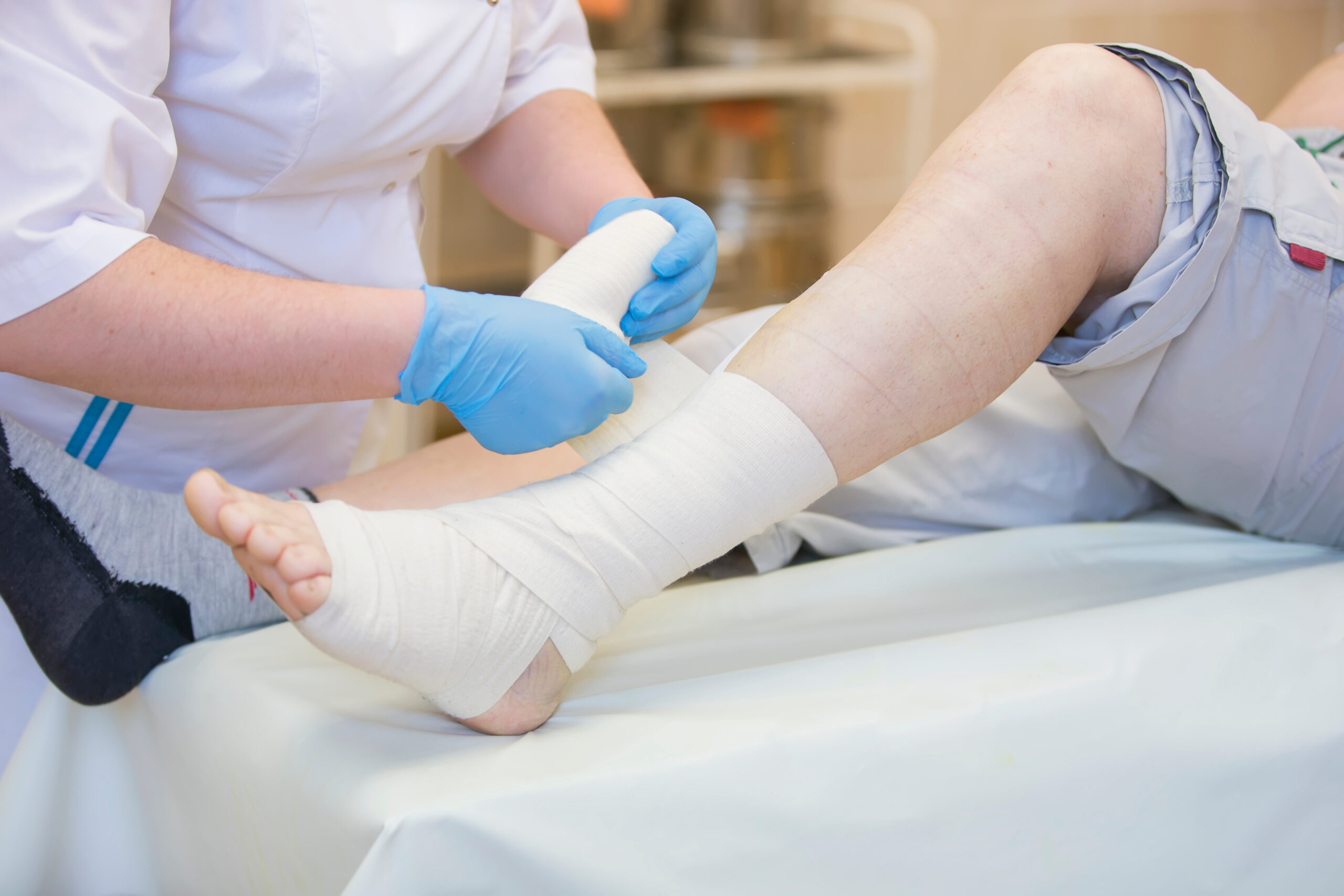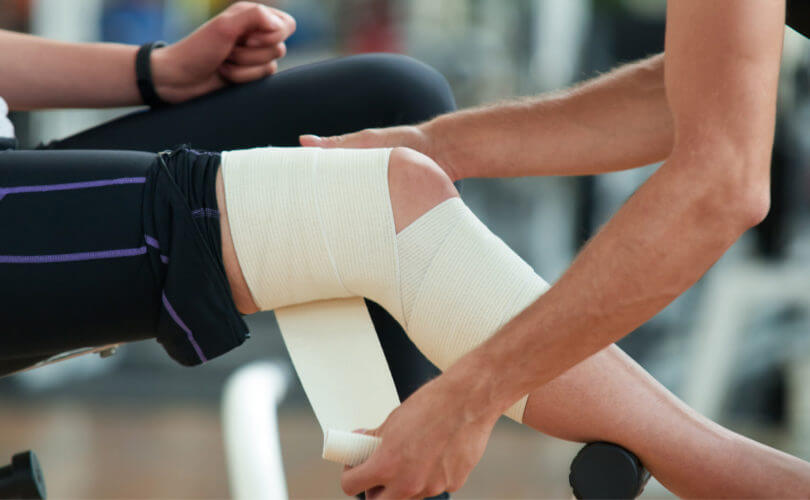The human knee, a remarkable and complex joint, plays a pivotal role in our daily lives, enabling us to walk, run, jump, and perform a myriad of activities. However, it is also one of the most vulnerable areas of the body, prone to injuries and strains. Whether you’re an athlete seeking to prevent sports-related injuries or someone recovering from a knee ailment, knowing how to properly wrap a knee is an essential skill. In this comprehensive guide, we’ll delve into four highly effective techniques for knee wrapping, taking you step by step through the process to ensure optimal support and stability.

Knee injuries and discomfort can be caused by various factors, such as overuse, accidents, or underlying medical conditions. They not only disrupt our daily routines but also hinder our ability to engage in physical activities we love. This guide is designed to empower you with the knowledge and practical skills needed to provide your knees with the support they require, helping you alleviate pain and discomfort while promoting the healing process.
Check out our Knee Pads for Comfort and Relief
We understand that the world of knee wrapping can be daunting, with a plethora of methods and conflicting advice available. That’s why we’ve carefully curated four of the most proven and effective techniques for you, backed by expert knowledge and experience. From the traditional figure-eight wrap to the more advanced patellar taping, we will guide you through each method, breaking down the steps in a clear and concise manner.
Whether you’re an athlete, a fitness enthusiast, or someone simply looking to maintain the health of your knees, this guide caters to all, providing a wealth of knowledge and hands-on instructions. We’ll discuss the significance of knee wrapping, how it can aid in injury prevention and recovery, and why choosing the right method matters. Our step-by-step instructions, accompanied by illustrations, will ensure that you can confidently and correctly apply these techniques to your own knees.
By the end of this guide, you’ll have a deeper understanding of knee wrapping and the skills to put it into practice. You’ll be well-equipped to make informed decisions about which method suits your needs best, whether you’re aiming for enhanced performance on the field or simply striving for a more pain-free and active lifestyle.
Join us on this journey of knee wellness as we explore the art of knee wrapping, empowering you with the tools to protect and support this crucial joint. With our step-by-step instructions and insights, you’ll be on your way to maintaining stronger and healthier knees, allowing you to confidently stride towards a more active and pain-free future.
The Importance of Proper Knee Wrapping
Before delving into the specifics of each knee wrapping technique, it’s crucial to understand the importance of this practice. Knee wrapping is not just a ritual for athletes; it’s a versatile skill that can benefit individuals from all walks of life.
- Injury Prevention: Wrapping your knee correctly can provide valuable support to the joint, reducing the risk of strain and injury. This is particularly important for athletes who engage in high-impact activities and individuals with a history of knee problems.
- Pain Management: For those already experiencing knee discomfort or pain, a well-applied wrap can alleviate these symptoms by providing stability to the joint and reducing strain on the affected area. It can be a crucial component of rehabilitation and recovery after injuries.
- Enhanced Performance: Athletes often use knee wraps to improve their performance by enhancing joint stability and reducing the likelihood of injury during sports or exercise. This extra support can provide the confidence to push their physical limits.
- Medical Conditions: Some individuals suffer from chronic knee conditions, such as osteoarthritis or patellofemoral pain syndrome. Proper knee wrapping can help manage these conditions, providing relief and facilitating daily activities.
Choosing the Right Technique
Each of the four techniques we will explore in this guide serves a unique purpose, and the choice depends on your specific needs.
- The Traditional Figure-Eight Wrap: This method is simple and effective, providing overall knee support. It’s an excellent choice for everyday activities or when you need light to moderate support.
- The Patellar Taping Technique: This method targets the patella (kneecap) specifically, offering localized support. It’s commonly used by athletes to enhance performance and alleviate patellar-related issues.
- The Compression Wrap: Ideal for managing swelling and providing consistent pressure, the compression wrap is beneficial after injuries or surgeries.
- The Hinged Knee Brace: This technique combines support with the flexibility of a hinged brace. It’s perfect for individuals recovering from knee surgery or those who need substantial support during physical activities.
In the upcoming sections of this guide, we will provide step-by-step instructions for each of these techniques, along with practical tips and considerations to ensure you make the most out of your knee wrapping efforts.
Conclusion
Understanding how to properly wrap a knee is an invaluable skill that can make a significant difference in your life, whether you are an athlete looking to enhance performance, someone in need of pain relief, or simply interested in maintaining healthy knees. Each of the four techniques discussed in this guide offers a tailored approach to knee support, ensuring you have the flexibility to choose the method that suits your unique requirements.
As you embark on this journey of knee wellness, we encourage you to explore each technique, practice diligently, and become familiar with the intricacies of knee wrapping. With this knowledge and practical experience, you will not only protect and support your knees but also regain the confidence to lead an active and pain-free life. So, let’s get started on the path to healthier, stronger knees, one wrap at a time.
Practical Steps for Effective Knee Wrapping
In the following sections, we will provide detailed instructions for each of the four knee wrapping techniques. It’s essential to follow these steps carefully to ensure optimal support and protection for your knee joint.
1. The Traditional Figure-Eight Wrap:
- Start by positioning the knee at a 90-degree angle, with the leg extended.
- Begin wrapping just below the knee, making a figure-eight pattern by crossing the wrap over the kneecap and around the leg.
- Secure the wrap just above the knee, ensuring it’s snug but not too tight.
2. The Patellar Taping Technique:
- Begin with the knee slightly bent, as this technique focuses on the patella.
- Apply adhesive tape in a Y-shape over the kneecap, starting from just below the patella and extending up the thigh.
- Gently stretch the tape to provide support, making sure it’s not too tight.
3. The Compression Wrap:
- Start with the knee slightly bent, to prevent constriction when it straightens during movement.
- Begin wrapping below the knee, working your way up the thigh, ensuring even pressure.
- Secure the wrap with clips or Velcro fasteners, making sure it’s snug but not cutting off circulation.
4. The Hinged Knee Brace:
- Place the hinged knee brace over the affected knee.
- Adjust the straps to provide the desired level of support and comfort.
- Ensure the brace allows for natural movement while providing the necessary support.
Remember to consult with a medical professional or a sports therapist for guidance, especially if you’re dealing with a specific injury or medical condition. They can provide personalized advice and ensure that you’re using the right technique for your unique situation.
Tips and Considerations:
- Always apply knee wraps on clean, dry skin to ensure proper adhesion.
- Avoid wrapping too tightly, as this can cut off circulation and lead to discomfort or injury.
- Listen to your body. If you experience increased pain or discomfort while wrapping, stop immediately and consult a healthcare professional.
- Regularly inspect your wraps or braces for signs of wear and tear, replacing them when needed to maintain their effectiveness.
Maintaining Knee Health Beyond Wrapping
While knee wrapping can be an effective way to provide immediate support and relief, it’s essential to complement it with other strategies to ensure the long-term health and well-being of your knees. Here are some additional steps you can take:
- Exercise and Strengthening: Engage in regular knee-strengthening exercises that can help improve joint stability and prevent injuries. Work on your quadriceps, hamstrings, and calf muscles to provide better support to your knees.
- Maintain a Healthy Weight: Excess weight can put extra strain on your knees. Maintaining a healthy weight through diet and exercise can reduce the risk of knee-related issues.
- Proper Footwear: Invest in comfortable, supportive footwear that offers adequate cushioning and arch support. This can significantly reduce the stress on your knees during everyday activities.
- Balanced Diet: Ensure your diet includes nutrients that promote joint health, such as omega-3 fatty acids, vitamin D, and antioxidants. These can help reduce inflammation and support overall joint function.
- Hydration: Staying adequately hydrated is essential for maintaining joint health. Water helps keep the cartilage in your knees lubricated and functioning properly.
- Rest and Recovery: Give your knees time to rest and recover after intense physical activities. Overexertion can lead to injuries, so adequate rest is crucial.
- Regular Check-Ups: If you have recurring knee problems or concerns about your joint health, consult with a healthcare professional. They can provide personalized advice, diagnose underlying issues, and recommend appropriate treatments or interventions.
- Physical Therapy: Physical therapists can offer targeted exercises and techniques to address specific knee issues, enhance recovery, and improve your overall knee health.
- Knee-Friendly Activities: Explore low-impact or knee-friendly activities such as swimming or cycling, which reduce the stress on your knee joints.
- Warm-Up and Stretching: Always warm up before exercise and incorporate stretching into your routine to increase flexibility and reduce the risk of injury.
In conclusion, learning how to wrap a knee effectively is a valuable skill that can contribute to a healthier and more active lifestyle. By understanding the importance of knee wrapping, selecting the right technique for your needs, and following the proper steps, you can provide the support your knee requires to prevent injuries, manage pain, and even enhance your performance in various activities.
As you embark on your journey towards better knee health, remember that practice makes perfect. Over time, you’ll become more proficient in your chosen knee wrapping technique, and you’ll gain the confidence to tackle any physical challenge with stability and comfort. So, embrace the knowledge shared in this guide and start wrapping your way to stronger, pain-free knees.





